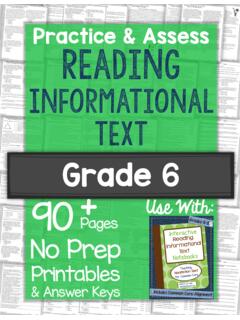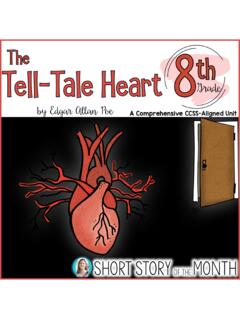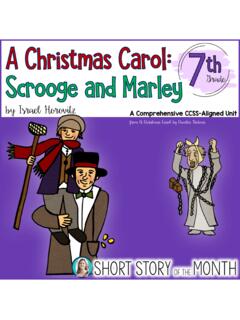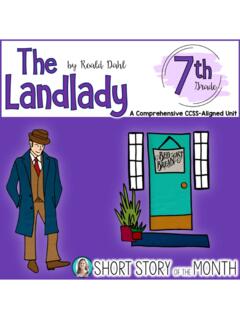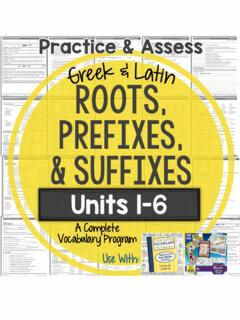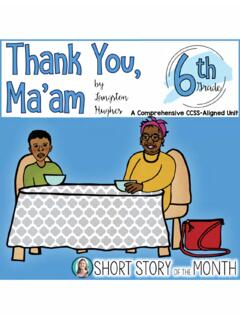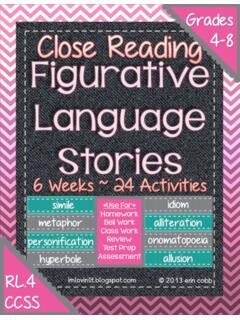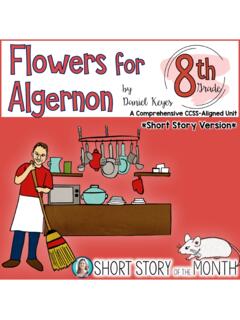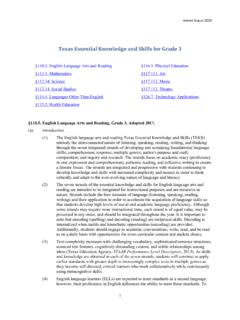Transcription of Interactive Reading Literature Notebooks - I'm Lovin' Lit
1 Interactive Reading Literature NOTEBOOKS3 Table of ContentsTerms of Use2 Table of Contents3-4 How-To Videos (NEW!)5 GETTING STARTED GUIDE FOR Interactive NOTEBOOKS6-9 Lesson 1: Basic StoryVocabulary Completed Student Pages10 Lesson 1: Basic StoryVocabulary Teacher s Instructions11-13 Lesson 1: Basic StoryVocabulary Student Pages14-15 Lesson 2: Elements of Plot & The Plot Pyramid Completed Student Pages16 Lesson 2: Elements of Plot & The Plot Pyramid Teacher s Instructions17-21 Lesson 2: Elements of Plot & The Plot Pyramid Student Pages22-31 Lesson 2: Bonus Activity Student Example32 Lesson 2: Bonus Activity Student Page33 Lesson 3.
2 Internal & External Conflict Completed Student Pages34-35 Lesson 3: Internal & External Conflict Teacher s Instructions36-37 Lesson 3: Internal & External Conflict Student Pages38-39 Lesson 4: Four Types of Conflict Completed Student Pages40-41 Lesson 4: Four Types of Conflict Teacher s Instructions42 Lesson 4: Four Types of Conflict Student Pages43-45 Lesson 5: Story Devices Completed Student Pages46 Lesson 5: Story Devices Teacher s Instructions47 Lesson 5: Story Devices Student Pages48 Lesson 6: Character Traits Completed Student Pages49 Lesson 6: Character TraitsTeacher s Instructions50 Lesson 6: Character Traits Student Pages51 Lesson 7: Characterization Completed Student Pages52-54 Lesson 7: Characterization Teacher s Instructions55-56 Lesson 7: Characterization Student Pages57-67 2013-2016 erin of ContentsLesson 8: Types of Characters Completed Student Pages68 Lesson 8: Types of Characters Teacher s Instructions69-70 Lesson 8: Types of Characters Student Pages71-73 Lesson 9: Theme Completed Student Pages74-76 Lesson 9.
3 ThemeTeacher s Instructions77 Lesson 9: ThemeStudent Pages78-79 Lesson 10: Point of View Completed Student Pages80 Lesson 10: Point of View Teacher s Instructions81 Lesson 10: Point of View Student Pages82-84 Lessons 11-19: Figurative Language & Card Sort Teacher s Instructions85 Lessons 11-19: Figurative Language & Card Sort Completed Student Pages86-93 Lessons 11-19: Figurative Language & Card Sort Student Pages94-104 Lessons 20-21: Figurative Language Review Completed Student Pages105-107 Lessons 20-21: Figurative Language Review Teacher s Instructions108-109 Lessons 20-21: Figurative Language Review Student Pages110-115 Lesson 22: Mood and Tone Completed Student Pages116-117 Lesson 22: Mood and Tone Teacher s Instructions118 Lesson 22: Mood and Tone Student Pages119-121 Lesson 23: Genres of Fiction (Novel Genres) Completed Student Pages122-123 Lesson 23: Genres of Fiction (Novel Genres) Teacher s Instructions124-126 Lesson 23: Genres of Fiction (Novel Genres)Student Pages127-134 Lesson 24: Folktale Genres Completed Student Pages135 Lesson 24.
4 Folktale Genres Teacher s Instructions136-137 Lesson 24: Folktale Genres Student Pages138-139 Common Core Alignment140-141 TEKS Alignment142-143 2013-2016 erin Reading Literature NOTEBOOKS5 How-To V i d eo s 2013-2016 erin Reading Literature NOTEBOOKSThe most exciting update included with this notebook is the all-new How-To V i d e o s posted for each 3-D activity!You c an fin d t h e se v id e os p ost e d on my You Tu b e c h an n e l h e r e : have created a playlist for all Reading Literature foldableshere: have included links for each activity s how-to video on that lesson s teacher s instructions page, and I have also listed them in an easy reference chart below.
5 ACTIVITYHOW- TO VIDEOL esson 1 Activity 1 1 Activity 2 2 Activity 1 2 Activity 2 2 Activity 3 3 4 Activity 1 5 6 7 Activity 2 8 Activity 1 10 11- 19 20 Activity 1 20 Activity 2 22 23 24 should I use Interactive Notebooks when I m already struggling to fit everything into my day? Interactive Notebooks should not be another thing added to your day on top of what you are already doing. Instead, change what you are already doing to accommodate Interactive Notebooks .
6 As a middle school teacher, I was already having my students take notes into their Notebooks anytime I taught new content (such as what is included in this packet). Interactive notebookingtook the place of my giving notes. I consider the time it takes my students to construct their Interactive notes as part of my explicit instruction time. And it is so much more meaningful than a lecture! When students construct these 3D graphic organizers and then put the information they are learning into them, they are making connections and organizing these topics in their brains in a different and more meaningful way than they would be if I were simply lecturing this material or if they were simply taking notes.
7 Furthermore, most of my Interactive notes are organized in a way that students can study them like flashcards without having to go through the trouble of writing out I have to use composition Notebooks ?Although teachers have successfully used spiral Notebooks for Interactive notebooking, composition books are truly better. They are more durable, less likely to fall apart, and the pages are far less likely to get torn out. I first decided to use Interactive Notebooks after a summer workshop when school supplies had already been ordered. Since I have about 150 students, my school (mandates that students purchase pre-packaged supplies) had already purchased 150 Five Star spiral 3-subject Notebooks for me.
8 No way was I getting composition Notebooks on top of that! So I waited for them to go on sale at Wal-Mart and Target for $ each and slowly purchased 150 of them, about 40 at a time. Some were also purchased (in limited quantities) at Big Lots and Walgreens for as low as $ , you can still implement Interactive 3d graphic organizers without ever putting them into a notebook if this works better for you. One teacher I met makes lapbooks for each of her social studies units. After she grades them and shows students their grades, she collects the unit lapbooks and files them.
9 Then, she hands them all back before state testing so that students can study. If you re interested in compiling these into lapbooks, here s a great tutorial on constructing lapbooks: Reading Literature Notebooks , BOOK 2 Interactive Notebooks ~ Getting Started Guide 2013-2016 erin the type of glue really matter?Absolutely! You definitely need to use Elmer s school glue when gluing items into your Interactive Notebooks . Many students may purchase and use the glue sticks, but these are definitely not recommended for Interactive notebooking. Yes, they re more convenient and less messy, but they will not bond the paper permanently.
10 I always tell my students that we use liquid glue because it will stick forever. Not only does the type of glue matter, but the method of gluing matters also. Here s a tip I learned at a workshop: NO TOASTER STRUDELING! You know what I m talking about, and your kids will LOVE this analogy. I even begin by putting an image of a yummy cream cheese toaster strudel up on my SmartBoardand asking my students if they ve ever eaten one. Most of them have. Do you like putting on the icing? Most students will say it s their favorite part! Well, you will NOT be toaster strudelingin my classroom!
